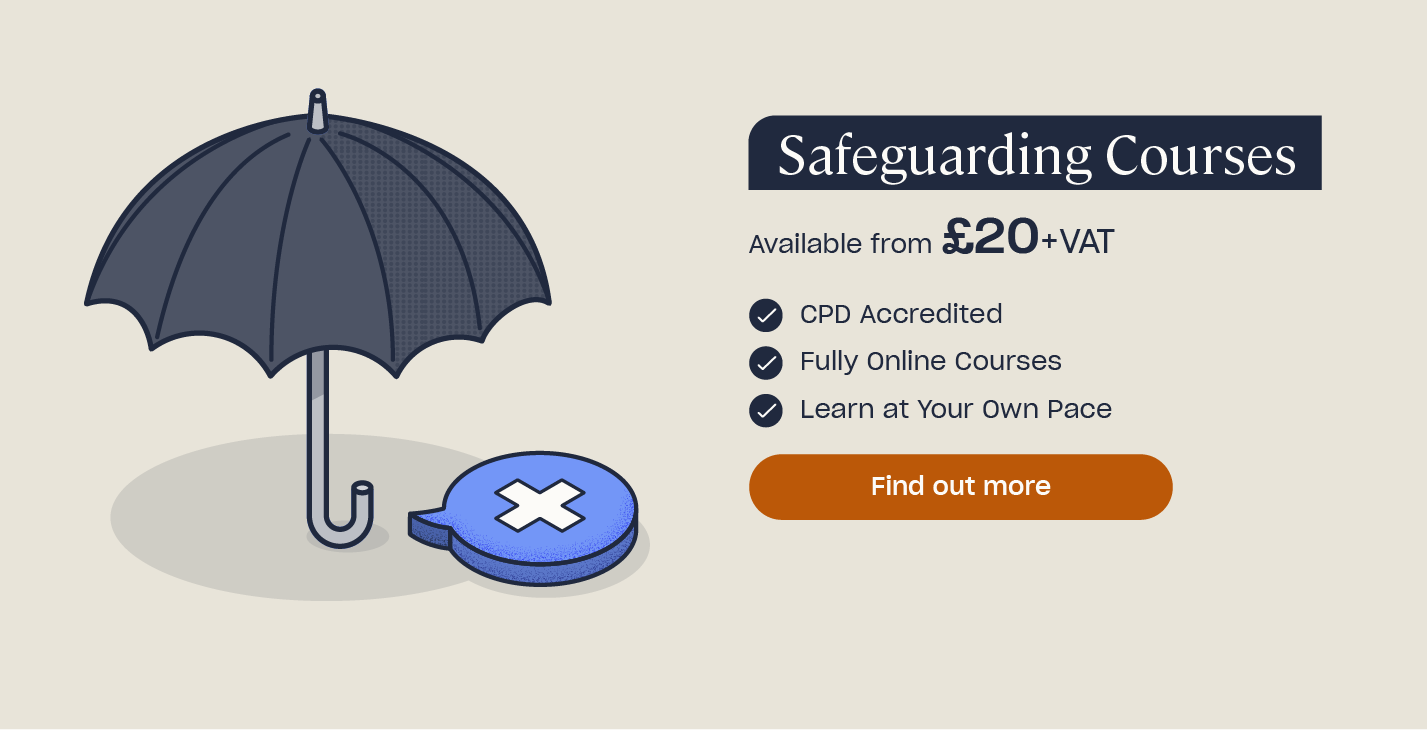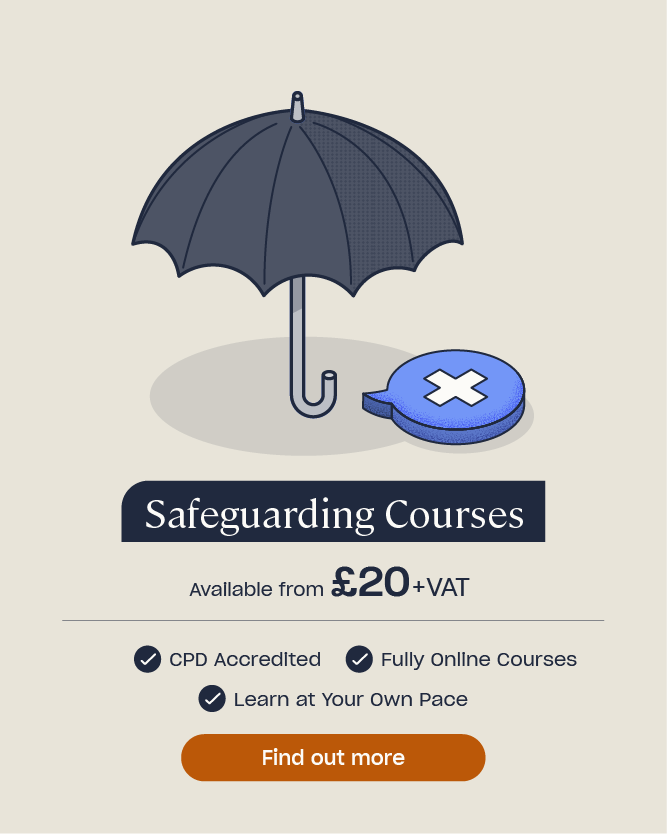What is Safeguarding Training & Why is it so Important?
As someone who works, or volunteers, with children or in a health or social care context, you should understand the importance of safeguarding. Receiving regular safeguarding training and updates will help create an effective safeguarding culture, which is key to ensuring people thrive. Training will also help you to recognise signs of abuse, stay informed about emerging risks and ensure you know how to respond to concerns.
Everyone is entitled to live their lives free from harm, and it’s important that all children and all adults at risk of harm can feel safe and protected.
Safeguarding is everyone’s responsibility. If you have any concerns, training will help you understand what steps you need to take. Schools, charities, hospitals and care homes, along with other organisations, must all be invested in safeguarding and have legal responsibilities to provide safeguarding training for staff. It’s important that everyone is adequately trained so they can carry out their safeguarding duties competently.
Need Safeguarding Training?
Our range of Safeguarding Training aims to provide you with the required knowledge to carry out your work whilst meeting safeguarding training requirements. Take a look at our Safeguarding Children course library where you’ll find everything from Designated Safeguarding Lead to Child Mental Health. You can also find our Safeguarding Adults course library here.
What is Safeguarding?
The term safeguarding is used to define actions taken to protect at risk groups from harm. This harm might come from adults or children and, as someone working closely with groups who have care and support needs, it’s important you understand what safeguarding is and why it’s important.
Safeguarding Children
Statutory guidance, Working Together to Safeguard Children, defines safeguarding and promoting the welfare of children as:
- Protecting children from maltreatment.
- Preventing impairment of children’s mental and physical health or development.
- Ensuring that children grow up in circumstances consistent with the provision of safe and effective care.
- Taking action to enable all children to have the best outcomes.
Child protection is a part of safeguarding and promoting welfare. This refers to the action taken to protect specific children who are suffering, or are likely to suffer from, harm.
All children are covered by child protection and safeguarding guidance and legislation.

Adults with Safeguarding Needs
The term ‘vulnerable adult’ had been used for many years in safeguarding training, policies and procedures. It has since been replaced with the new definition found in the Care Act 2014, as it was seen as disempowering. Adult safeguarding means working with those who are aged 18 years and above with care and support needs, to keep them safe from abuse or neglect. Terms used to replace ‘vulnerable adults’ include:
- Adults at risk of harm.
- Adults at risk.
- Adults with care and support needs.
- Adults in need.
This not only refers to adults who lack capacity. Adults with full capacity can still be considered at risk, if they are unable to take care of themselves or protect themselves from significant harm or risk of harm.
Safeguarding refers to the actions you take to protect adults with care and support needs from harm. The purpose of safeguarding is to ensure that all adults:
- Are involved in making decisions about their lives.
- Have a good quality of life.
- Have their needs and interests respected.
- Have their human rights respected and upheld.
- Are responded to appropriately if they have any concerns.
- Have their views, wishes, feelings and beliefs taken into account.
Why is Safeguarding Important?
Everyone has a right to live their lives free from fear, abuse and neglect. If you work with or around groups who might be at risk of harm, you have a responsibility to promote their welfare and to safeguard them.
Missing potential warning signs could have serious consequences and leave individuals open to abuse, neglect and exploitation.
Why is Safeguarding Important in Schools?
Schools and education settings have a legal responsibility to safeguard all pupils. Statutory guidance, Keeping Children Safe in Education (KCSIE), is regularly updated to ensure that schools are clear in their safeguarding responsibilities. The guidance responds to evolving risks and details the knowledge and practices that should be in place to ensure effective safeguarding in schools and colleges. This includes the requirements for safeguarding training and keeping knowledge up to date.
Ofsted inspections will consider how effective the culture of safeguarding is within a setting. Detailed information regarding how to create an effective culture of safeguarding in schools can be found in our article here.
Child abuse causes trauma. It is widely recognised that adversity and trauma can have long lasting effects on a child’s mental health, behaviour and education. These effects can last well into adulthood.
KCSIE states that staff should ‘consider how safeguarding, welfare and education outcomes are linked’. Children who suffer from abuse and neglect are more at risk of lower academic achievement, which in turn can lead to negative life outcomes.
Settings should have a child-centred approach where children know how to access support and feel that they will be listened to and their needs understood.
However, many children may not disclose abuse or neglect, or even be aware that what they are experiencing is wrong.
All staff, including volunteers, should be appropriately trained to recognise and respond to signs of abuse and neglect. Safeguarding training will also help to identify which groups are more likely to be susceptible to abuse, such as children with Special Educational Needs, those who identify as, or are perceived to be, LGBTQ+ and children in care.
Why is Safeguarding Important in Healthcare?
Abuse and neglect can occur anytime and anywhere, which is why it is so important that everyone is aware of safeguarding issues. You have a responsibility to protect those in your care and their fundamental right to live a life that is safe and free from harm.
The Care Act 2014 Statutory Guidance defines adult safeguarding as ‘protecting an adult’s right to live in safety, free from abuse and neglect. It is about people and organisations working together to prevent and stop both the risks and experience of abuse or neglect.’
As someone working or volunteering in a healthcare setting, such as a hospital or care home, it is part of your role to meet those safeguarding responsibilities. Dignity is an important part of safeguarding and means putting the individual’s wants and needs at the centre of your work and providing care in a respectful way.
Benefits of Safeguarding Training
Unfortunately, there have been many tragic consequences of failing to follow vital safeguarding practices. Reviews of such cases highlight many missed opportunities to address safeguarding risks. They have uncovered recurring issues, such as failure to act on signs of abuse and neglect, poor information recording and sharing and failure to listen to the views of the individual.
Safeguarding training is vital to address these issues and avoid safeguarding failures. When working with groups who are more at risk, training will help you to understand how the legislation underpins the statutory guidance, which in turn informs policies and procedures within a setting. Regular safeguarding training helps to ensure that all employees can carry out their duties knowledgeably and safely.

Safeguarding training will help you to understand your role, how to identify risks, recognise and confidently respond to signs of abuse or neglect, and know what next steps you need to take, including how to escalate concerns.
Further Resources:
- Designated Safeguarding Lead Training
- Guide to Safeguarding Children in Sport
- What are the 6 Principles of the Care Act?
- Safeguarding for Taxi Drivers Quiz
- Safeguarding Adults Quiz
- Safeguarding Training Levels Explained: What’s the Difference?











